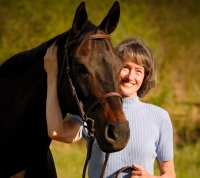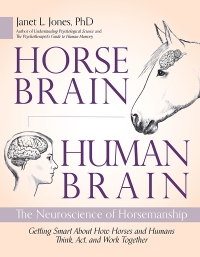TRUE TRAINING 3 - The Harder Catch
In the last post, we talked about teaching a new horse to be caught. The strongest mental lesson is formed if we teach the horse to come to us, rather than allowing us to approach her. Suppose all the ideal conditions are met—the horse is young and new, she’s housed alone for a few days, the catch location is small, and you’ve tried the technique I described—but still, Her Majesty won’t approach.
First, make a plan. Horses are prey animals—their brains automatically perceive direct eye contact, strong movement, and military posture as threats, at least until taught otherwise. Body position is critical. Enter the gate casually and call your horse’s name. Be sure she sees and hears you. When she looks your way, turn your face to the side, lowered so you can see foot movement from the corners of your eyes. Slouch a little, poke the dirt with your toe. Look down, squat down. Wait.
No go? That’s OK, amble closer, calling the horse’s name again. Stop occasionally, slouch, turn sideways, wait. Squat down. If necessary, stop for a minute with your back to the horse, then begin walking away. Many horses change their tune as soon as you begin to leave, as if to say “Hey, wait a minute! Where ya goin’?” Go slowly with all this. She’s afraid; give her time.
As soon as the horse comes your way, say her name, especially in the last few feet of approach. You want her brain to link her name with the action of coming to you and with the rare edible reward she’s about to enjoy. When she arrives, immediately offer the reward along with strokes and praise. (A hidden reward, not a lure—shaking the can of grain ahead of time teaches her to come to the grain. We want her to come to you.)
This technique works with most new youngsters, although you might have to use it two or three days in a row before achieving success. But suppose your little monkey is among the most resistant. (Sell her immediately! No, of course, I’m only joking.) Meander toward her shoulder gently, enlisting help from a friend only if she whirls away repeatedly. Stroke her for a minute, then step about six feet back. See if she will take one step in your direction. If so, give her the best tasting edible reward you can muster. Not a carrot, more like a bite of carrot cake! (You’re only going to use this level of food reward once or twice, so splurge a little.) You want to surprise this horse’s brain into releasing a giant spurt of dopamine that says, “Wow, that felt great!” Stroke, praise, turn gently, and leave. That’s enough for today. If she follows you, stroke, reward, and leave again.
If the horse is very skittish, get within 20 feet or so, then turn and move backward toward her very slowly. (For your safety, be sure the horse has space to escape you when your back is turned.) If the halter frightens this horse, don’t use it yet. Your present goal is to get only one approaching step out of her. The others will come later. Eventually, you can add the halter, enlarge the catch space, follow catching with work, and save edible rewards for more complicated maneuvers. Rome wasn’t built in a day.
Please remember, this technique is for young, new horses… it doesn’t always work with established adult evaders who might have endured years of poor catching before you came along. People try all sorts of silly tricks, even chasing hard-to-catch horses with vehicles or running them to exhaustion. These only make the problem worse. Give my tips a try, but if your adult horse routinely runs from you, you need individual consultation or on-site training instead of a blog.
You’re teaching the horse two important lessons with all this—to allow you to catch her easily, and to learn to trust you. If done well, both will stick in her mind for years to come. Good luck!

